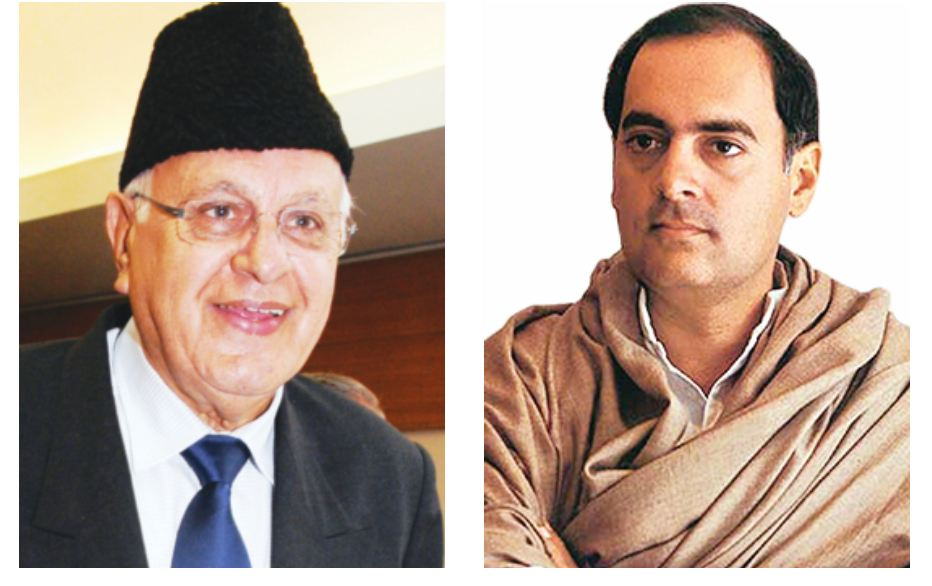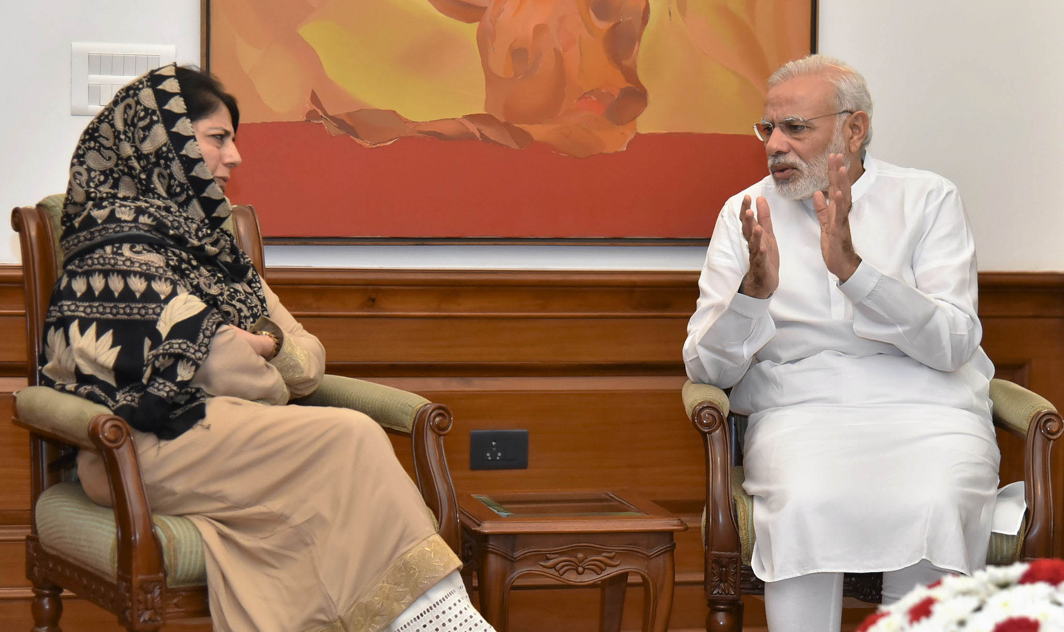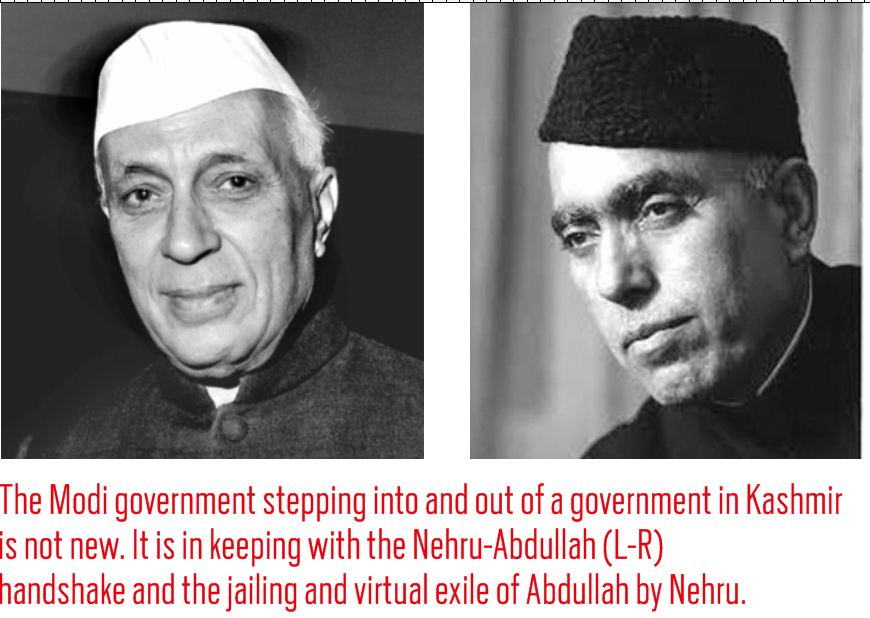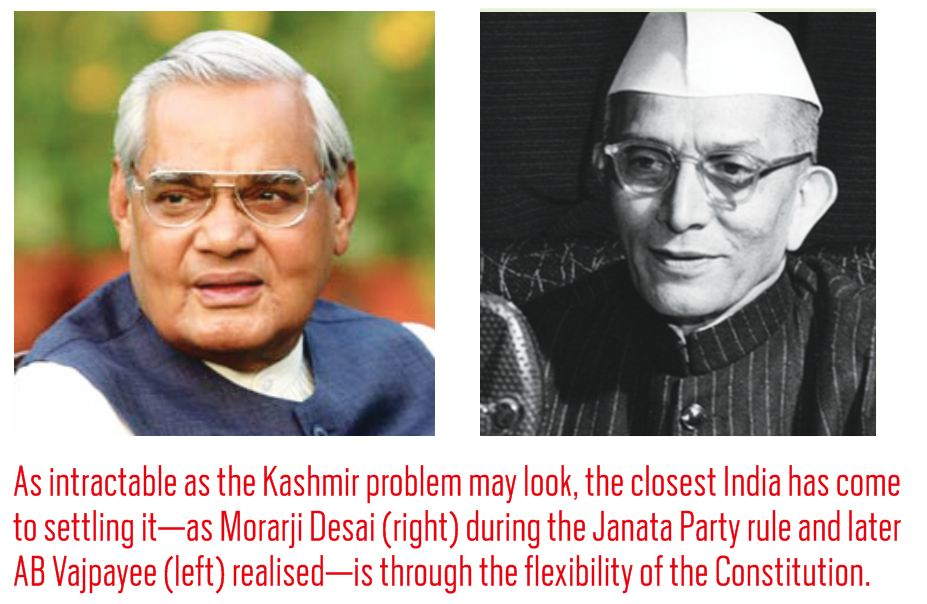~By Inderjit Badhwar
The latest political crisis in Jammu and Kashmir (J&K) in which a government ruling in Delhi has pulled the rug out from under the feet of its regional coalition partner brings to mind two utterances from National Conference leader Sheikh Abdullah—the Lion of Kashmir—who straddled the state like a colossus whether as a freedom fighter, a political prisoner or a chief executive before and after India’s Independence.
After Indian armed forces pushed back Pakistani invaders who had attacked J&K to accomplish a military annexation of the erstwhile princely state, the issue was discussed extensively by the UN’s General Assembly and Security Council. Participating in these discussions, the then prime minister of the state’s emergency government, Sheikh Abdullah, made a speech in the Security Council on February 5, 1948 slamming Pakistan’s legitimacy in staking any kind of post-Partition claim over the state, which had signed the Instrument of Accession to the Indian Union.
“The Government of India could easily have accepted the accession and could have said, ‘All right, we accept your accession and we shall render this help’. There was no necessity for the Prime Minister of India to add the proviso, when accepting the accession, that ‘India does not want to take advantage of the difficult situation in Kashmir. We will accept this accession because, without Kashmir’s acceding to the Indian dominion, we are not in a position to render any military help. But once the country is free from the raiders, marauders and looters, this accession will be subject to ratification by the people.’ That was the offer made by the Prime Minister of India.

“The question is not that we want internal freedom; the question is not how the Maharaja got his State, or whether or not he is sovereign… We should prove before the Security Council that Kashmir and the people of Kashmir have lawfully and constitutionally acceded to the Dominion of India, and Pakistan has no right to question that accession.”
About three decades later, Abdullah, rendering an emotional apology to his people for allying with the Congress party which had jailed him for his quest for greater autonomy was to intone the poet Iqbal: “Ae taire-lahoti is rizq se mout achi –jis rizq se aati ho parwaz me kotahi. (O ethereal bird! It is better to starve to death, than to live on a prey that clogs thy wings in flight.”
Once the symbol of accession to India in 1947, Sheikh sahib was now seen as a symbol of secession. Karl Marx said that history repeats itself, first as tragedy, second as farce. In which stage this cyclical dialectic is going to evolve within the coming year after the declaration of governor’s rule in J&K last week, is difficult to predict. But the repetition of things past has begun. The more things change, the more they remain the same is all that I can make out of the current imbroglio.
Several future scenarios are already developing. The most popular one is that Kashmir will replace Ayodhya as the BJP’s new polarization issue where Hindutva hardliners will adopt the hyper-nationalistic stance of condemning all those opposed to a full-fledged military crackdown on militants, a no-talking-to-Pakistan strategy, creating “outsider” (read Hindu) migrant settlements in Muslim areas by diluting Article 370 and 35-A which give special status to the permanent residents of the state, as anti-national and anti-Hindu pseudo-secular appeasers. In this battle, Prime Minister Modi will be projected as the loh purush (iron man) of India who sacrificed his party’s interest by withdrawing support to ruling coalition partner PDP because it was “soft” on Islamic terrorists.
India has learned to control Kashmir through a combination of politics, democracy whenever possible, force when needed, undercover operations, money, bribes, sting operations, chicanery, jingoism, and cajoling puppet leaders
A top-ranking retired government luminary, with influence in the administration, told me: “Thousands of people have already been killed on both sides. Maybe India should take the plunge and declare a fight to the finish once and for all while also scrapping Article 370 and encouraging non-Muslim settlements and land purchases by outsiders in the Valley.”
But he was sobered by the thought that such a gamble would entail the risk of a prolonged civil war, the commitment of India’s already over-stretched armed forces, perhaps a Syria-like situation with shades of Gaza and the West Bank. It could also create a refugee and cross-border migration flood and lead to Kashmir’s “Afghanistanization” and the interference of foreign powers which would totally negate the Shimla Accord.
Actually, as intractable as the Kashmir problem may look, the closest India has come to settling it—as Morarji Desai during the Janata Party rule and later Atal Behari Vajpayee realised—is through the flexibility of the Indian Constitution which implicitly and explicitly recognises through various Articles, starting with Article 2, that different Indian states because of their history, ethnicity, linguistic compulsions, cultural diversity and customs have different needs and “special status” is not a dirty word. It applies not only to Kashmir but several other states already, and is being demanded by others such as Andhra, Karnataka, Odisha and Bihar.

Accords with rebellious states—in the north-east, and even with the south and west if you count linguistic boundaries—have been de rigueur in India’s political development, and they have come cheaper by the dozen in J&K, hence my earlier reference to history as tragedy and farce.
I wrote in the late 1980s that the history of Kashmir is a tortuous web of intrigue, blackmail, reconciliation, deception and revolt. Cut off from the rest of the country for six months a year by high mountain ranges, the people of the Valley have evolved distinct cultural patterns and a way of life they call Kashmiriyat. Eighty percent of the 35 lakh inhabitants are Muslims. Enslaved for centuries by Mughals, Pathans, Sikhs and Dogras, they believe they have never been a free people and have never been allowed democracy. The current crisis in Kashmir is deeply rooted in this past.
Except for some positive hiccups in between, the situation remains more or less the same except for the emergence of newer gangs of terrorist thugs like the Laskhar-e-Taiba who were unknown three decades ago when the conflict began to take an ominously violent turn. Indubitably, Kashmir continues to be India’s number one national security headache because of the bungling and sins of commissions and omissions that play lollypop-like into the ever-ready-to-stump-you Pakistan wicket-keeper’s hands.
Prime Minister Narendra Modi’s government stepping into and out of a government in Kashmir is neither new nor surprising nor unprecedented. It is, in fact, quite in keeping with traditions and tactics established by the Congress, starting with the Nehru-Abdullah handshake and the jailing and virtual exile of Abdullah by Nehru. Listen to former governor Jagmohan about the subsequent pact between Nehru’s grandson Prime Minister Rajiv Gandhi, and Abdullah’s son Farooq in 1986: “The unwritten accord was ‘a mere declaration to work together and form a coalition’ government. The Rajiv-Farooq Accord (November 1986) was another reflex of spurious democracy and the habit of nursing illusions. The accord might have yielded positive results if it had been inspired by reformative zeal and constructive approach. But both parties joined hands merely to serve their selfish ends. In practice, the accord only resulted in enlarging the circle of predatory and insensitive oligarchy.”
Kashmir will replace Ayodhya as the BJP’s new polarisation issue where Hindutva hardliners will condemn all those opposed to a military crackdown on militants, a no-talking-to-Pakistan strategy, creating “outsider” migrant settlements in Muslim areas by diluting Article 370 and 35-A
Sounds familiar?
Here’s another reminder of how the Congress played the game before the 1986 Rajiv-Farooq handshake. At that time, the Congress had finished toppling Farooq and replaced him with his brother-in-law Gul Shah. Here’s how Kashmir Life weekly’s Masood Hussain describes it: “With BK Nehru, (former Governor), her relative, unwilling to do the dirty job, Mrs Indira Gandhi picked up Jagmohan for tackling ‘boyish, inconsistent and erratic’ Farooq. Congress purchased 13 NC lawmakers and extended support by its 23-members to help Ghulam Mohammad Shah replace Farooq as Chief Minister. A bloody operation, Delhi purchased men in assembly dragged Speaker Wali Ittoo out as nearly 30 youth were killed in police firing.
“Corruption reigned as the new Chief Minister meekly signed on dotted lines every time Delhi wan-ted. Emergent explosive situation reduced Ghulam Mohammad Shah to Gula Curfew. He dismissed some government employees for ‘making bombs at home’. Gul Shah was ultimately thrown out by the centre because he failed to obey the Congress high command’s ultimate wish—to demolish the National Conference.”
Kashmir was very much a part of my life in the late eighties until the mid-nineties, after which, for a period, I had to avoid going to the Valley because I was on a militant hit list for taking a strong position against terrorist violence in my articles for India Today. I write this only to reiterate my appreciation for former RAW Chief AS Dulat’s 2015 book, Kashmir: The Vajpayee Years, for gauging the volatility of the Kashmiri issue—prone to sudden, mercurial shifts—and the changeability of the mindset of ordinary Kashmiris and their leaders.
I recalled my experience with Kashmir in an earlier piece for India Legal, in which I actually gave Modi full marks for his handshake with PDP’s Mufti and later with his daughter, Mehbooba, hoping that leading a secure and stable majority government would enable Modi to sidestep some of the earlier games insecure politicians had played with Kashmir. I repeat below excerpts from that article because I could have written it yesterday. The sense of déjà vu is overwhelming:
Briefly, I covered Kashmir from 1986 to 1991, and then returned to cover the 1996 election which has been described by Dulat as a political “master-stroke”. I saw the Congress-NC alliance between Rajiv Gandhi and Farooq Abdullah emerge in 1986 and then the fatally flawed and rigged February 1987 election in which the wildly popular, youth-oriented MUF party was trounced and moderates like Abdul Ghani Lone of the People’s Conference were hounded out of Handwara by NC goons. I wrote about that election: “Congress may have won an election but India has lost Kashmir.”
The consequent backlash, within the next couple of years was the emergence of the gun, street battles, political assassinations, repression, mass marches, bombings, disappearances. India had played into Pakistan’s hands. Since the late 1940s, after Indian troops helped Kashmir trounce and repel the Pakis-tani invaders, who had tried to take Kashmir by force, Pakistan had not succeeded in training and sending armed militants to try and destabilize Kashmir on the ideological premise of the two-nation theory that Muslims are a separate nation and Pakistan is their natural homeland.
It is remarkable that while Pakistan had been able to arm Khalistani militants in Punjab, it had failed to achieve the same result in Muslim-majority Kashmir.
This is largely because the Kashmiris are fiercely independent. After all, in 1948, most of the innocents butchered and raped in Anantnag and Baramulla by the Pakistani invaders were themselves Muslims. Historically, Kashmiris had fought the Afghans, Mughals, Dogra rulers, and Maharaja Ranjit Singh. Their concept of Kashmiriyat was—and is—based on their historical fight against, and then submission to, outside rulers who treated them with disdain.
That is why the concept of azaadi is so deeply ingrained in the Kashmiri psyche.
The various legal resolutions on the Line of Control, the Ceasefire, UN observers, plebiscite, passed in the United Nations as well as Article 370, while kept alive as debating points in Kashmir, do not really impact the internal reality of the Kashmiri psyche. The Kashmiri is taught as a child that he is the subject of the “Dilli Durbar” and anybody who makes a pact with “Dilli” is betraying Kashmir to “India”. He feels the same about Pakistan.
But he knows the real world. India, for the sake of its own ideological secular identity and unity will never cede Kashmir. The Kashmiri knows this. He may wave the Indian flag at times but, always, with two fingers crossed behind his back. India has learned to control Kashmir through a combination of politics, democracy whenever possible, force when necessary, undercover operations, money, bribes, sting operations, chicanery, jingoism, and cajoling puppet leaders. The Kashmiris have been smart enough not to escalate violence to such an extent that it would become a full-fledged armed rebellion inviting fearsome retribution. Both know where to draw the line. Both sides play the game.
Kashmiris are rewarded handsomely by India as well as from across the border. In their politics of blackmail—all Kashmiri parties participate in this—they use either the Pakistani or the Indian flag, whichever comes handy.
Indian politicians keep Kashmir alive because it is a handy tool to whip up nationalist fervour. Pakistan does the same because without claiming Kashmir on the grounds of its Muslim majority, the underpinning of their ideological identity as an Islamic state would collapse.
And so, the game goes on. This is the game that Dulat writes about so engagingly, and in the process, fills a yawning gap about what transpired in the 1990s in the spy-versus-spy humint game—far more effective than warfare or “encounter battles” in creating and weaning leaders to the Indian side. His account of the Shabir Shah game of nerves is brilliantly reconstructed, though I wish he would talk a little more about what we journalists called “Dulat’s Boys” or the “friendly militants” like Kuka Parrey who gave Pakistani operatives the fright of their lives.
The Kashmir dilemma is beautifully summed up by MJ Akbar in Kashmir: Behind the Vale: “Kashmir lies at the edge of India’s borders and at the heart of India’s consciousness. It is not geography that is the issue; Kashmir also guards the frontiers of ideology. If there was a glow of hope in the deepening shadows of a bitter partition, then it was Kashmir, whose people consciously rejected the false patriotism of fundamentalism and made common cause with secular India instead of theocratic Pakistan. Kashmir was, as Sheikh Abdullah said and Jawaharlal Nehru believed, a stabilizing force for India.”
According to the book’s summary, Kashmiriyat is the identity and culture that has blossomed within the ring of mountains for thousands of years. Akbar records Kashmir’s struggle in the century to first free itself from feudal oppression and then enter the world of modern India in 1947. “Placing the mistakes and triumphs of those early, formative years in the perspective of history, the author goes on to explain how the 1980s have opened the way for Kashmir’s hitherto marginalized secessionists. Both victory and defeat have their lessons; to forget either is to destabilize the future. Kashmir and the mother country are inextricably linked. India cannot afford to be defeated in her Kashmir.”
Each Indian prime minister writes his own chapter to the Kashmir story. One can only hope that Modi’s chapter will be fresh and someone in his administration will have learned the lessons spelt out in the books written by Dulat, Akbar, BK Nehru, Jagmohan and Cheema
Where Akbar left off, Dulat pitches in to take the narrative farther. But there are other important books that fit beautifully into the puzzle. Governor Jagmohan’s book, My Frozen Turbulence, is a scathing indictment of Delhi’s abysmal misunderstanding of the Kashmir issue and of the Kashmiri psyche and the policy of benign neglect alternating with gratuitous political gamesmanship and interference that farther fuelled militancy and violence in Kashmir just when successful doses of good governance under governor’s rule had helped to pacify much of the Valley.
Brigadier Amar Cheema’s The Crimson Chinar is a brilliant perspective on how India keeps blundering in its approach to Kashmir. He relies heavily on BK Nehru, former governor, Kashmir and Indira Gandhi’s cousin, in pinpointing the roots of discontent, starting with the arrest of Sheikh Abdullah, the “Lion of Kashmir,” in 1953, which virtually rendered the state’s Constituent Assembly a puppet grouping followed by a series of rigged or uncontested elections until 1976 which proved Indian claims of democracy in Kashmir a farce.
But Cheema is correct in pointing out that the Sheikh had himself become a corrupt and authoritarian leader and had completely rigged the election to the Constituent Assembly itself. History repeated itself in the 1987 election, largely fought on the corruption issue. The Farooq Abdullah government was widely perceived as venal to the core and the Sheikh Abdullah dynasty was as unpopular as the Shah of Iran before his downfall.
For Rajiv Gandhi to have allied with this corrupt party and then look away as the election was openly rigged and brazenly manipulated was the last straw. And both Kashmir and India are still paying the price.
Prime Minister Narendra Modi learns quickly from history and tends to avoid the pitfalls of his predecessors. So far, his Kashmir initiatives seemed to have been sensible and calibrated notwithstanding the increased violence and increased casualties among Indian security forces.
Each Indian prime minister writes his own chapter to the Kashmir story. One can only hope that Modi’s chapter will be fresh and someone in his administration will have learned the lessons spelt out in the books written by Dulat, Akbar, BK Nehru, Jagmohan and Cheema. Or will history repeat itself as farce and tragedy, as India heads out into the brave new world post the collapse of the BJP-PDP coalition?




